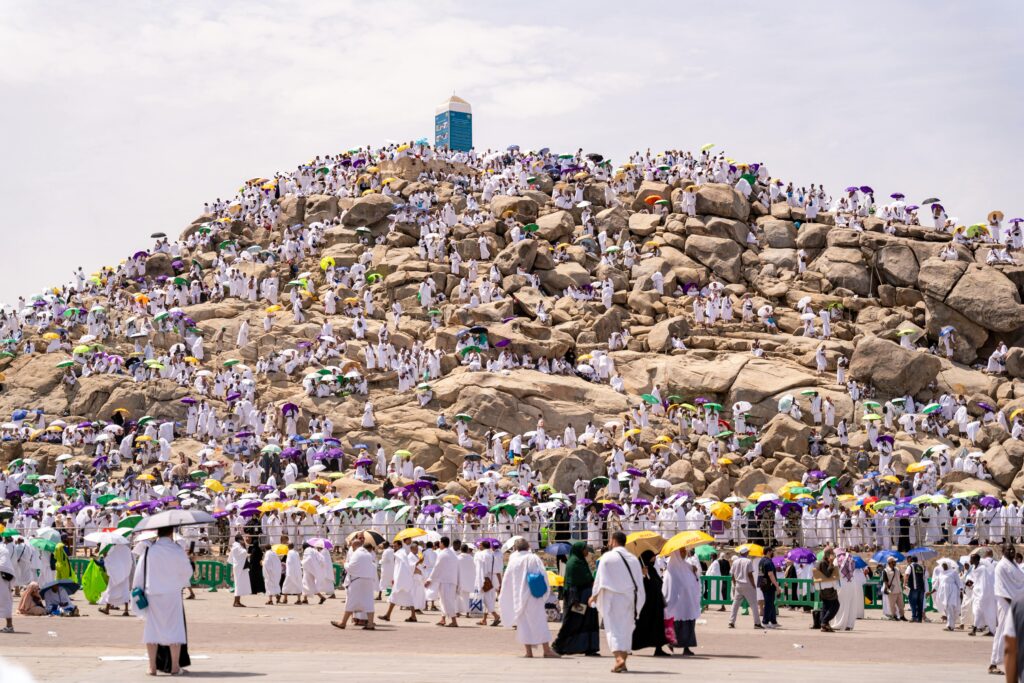
The Mut’ah of Hajj (“hajj al-tamattu”)
The Mut’ah of Hajj (“hajj al-tamattu ”): An All-Inclusive Manual. Every suitable-bodied and financially sufficient Muslim must at least formally go on the holy Hajj, the fifth pillar of Islam. Among the several forms of Hajj, Hajj al-Tamattu’s (Mut’ah of Hajj) unique significance lies especially in the Shia Islamic tradition. Unlike Hajj al-Ifrad or Hajj al-Qiran, this kind of Hajj consists of doing Umrah and Hajj independently with a break in between.
Knowing Mut’ah of Hajj (Hajj al-Tamattu’)

The Mut’ah of Hajj Meaning and Definitions
“Mut’ah of Hajj” is the term used to describe Hajj al-Tamattu,” thereby indicating “enjoyment Hajj.” This is so named since pilgrims experience the “enjoyment” of escaping Ihram’s constraints between Umrah and Hajj.
During this kind of the Hajj:
First (during the months of Hajj: Shawwal, Dhul-Qa’dah, and the first days of Dhul-Hijjah) the pilgrim does Umrah. Umrah ends; they leave the condition of Ihram. Then, on the eighth of Dhul-Hijjah, they re-enter Ihram for Hajj. This is not the same than Hajj al-ifrad (alone, without Umrah). Hajj al-Qiran, or one Ihram combined Umrah and Hajj. Quran Basis for the Hajj Al-Tamattu’
The Quran helps one to derive the permissibility of Hajj al-Tamattu’.
“So whoever performs the Umrah [during the Hajj months], followed by the Hajj, [offers] what can be obtained easily from sacrificial animals. If someone is unable to find or afford such an animal, they have three days during the Hajj and seven days following returning home.” That adds ten days overall. Quranic 2: 196
This chapter states that Umrah before Hajj is both allowed and even advised.
How to follow the Step-by– Step Guide Hajj al-Tamattu?
First step: arriving for Umrah in Ihram.
From one of the approved Miqat locations, the pilgrim has to enter the state of Ihram.
The aim (niyyah) should be for Umrah al-Tamattu’.
Recited is the Talbiyah: “Labbayk Allahumma Umratan Mut’amatan biha ila al-Hajj” (O Allah, I respond Your call by performing Umrah, enjoying it till Hajj).
Second: Following Umrah Rituals
Tawaf: Seven times Kaaba circling.
Sa’i: Seven times walked between Safa and Marwah.

Credit to Sureyya Aydin, Norway
Shaving the head (for men) or cutting a tiny bit of hair (for women) free the pilgrim from Ihram.
By now the pilgrim is free from Ihram constraints till the eighth of Dhul-Hijjah.
Third step: arriving for the Hajj in Ihram
With the goal of Hajj, the pilgrim re-enters Ihram from Mecca (or their place) on the eighth of Dhul-Hijjah.
Recited once more for the Hajj is the Talbiyah.
Step 4: Executing Hajj Ritualues
Remain in Mina, eighth Dhul-Hijjah.

At Arafat, 9th Dhul-Hijjah, Wuquf.
Muzdalifah, the night of 9th–10th Dhul-Hijjah.
Ramy al-Jamarat, stoning the demon.
• Sacrifice (HaHaHady)—part of Tamattu’s Hajj, an animal is killed.
Halq or Taqsir (again shaving or cutting hair).
Tawaf al-Ziyarah & Sa’i (if not done previously).
Tawaf al-Wida, or farewell Tawaf.
Variations amongst Hajj al-Tamattu‘, Hajj al-Ifrad, and Hajj al-Qiran

Credit to Sureyya Aydin, Norway. “Image created with AI”
Aspect Tajaj a Tamattu Haal-Qiran Definition ion n on n Umrah + Hajj (seIhrams) rams) Hajj alone; Umrahly, Umrahj (sin(s(single Ihram), hram), Ihram, am); Ihram Release After Umrah, before Hajj, onyady) Essential or not necessaryComplication Complexity oderateShia and certain Sunni schools choose SimpleComplex. Some Sunni educational institutionsSome Sunni educational institutions
Significance of Hajj al-Tamattu in Shia Islam
For individuals living outside Mecca (afaqi), Hajj al-Tamattu’s is regarded as the mandatory type of Hajj per Shia law. Based on:
The Quranic verse (2:196).
Hadiths stressing its excellence from the Ahlul Bayt (as).
Imam Ja’far al-Sadiq (as) remarked:
“Hajj al-Tamattu’ is required; whoever performs Hajj al-Ifrad or Qiran without a good reason has not fulfilled his obligation.”
Typical Mistakes Regarding the Hajj al-Tamattu’
First misconception: “It’s Only for Shia Muslims”.
Though some Sunni scholars—such as those in the Maliki and Shafi’i schools—also allow it, Shia scholars stress it.
Second misconception: “it’s more difficult than other types”.
Many find it simpler even if it entails two different Ihrams as they get a respite between Umrah and Hajj.
Third misconception: “The sacrifice is optional”.
No, in Tamattu’, the sacrifice (Hady) is obligatory unless the pilgrim cannot pay it; in such case, fasting is advised.
Advantage of Selecting Hajj al-Tamattu’
The vacation lets pilgrims relax and psychologically get ready for the Hajj.
Combining Umrah and Hajj magnificuates blessings.
Pilgrims can Umrah early and then concentrate just on the Hajj.
Conclusion
In Islam, Hajj al-Tamattu’ (Mut’ah of Hajj) is a reputable and quite fulfilling kind of pilgrimage. It guarantees that pilgrims may easily complete their responsibilities by offering a disciplined but flexible approach to do both Umrah and Hajj. Though Islamic schools vary on their need, their permissibility stems from the Quran and Hadiths.
Frequently Asked Questions (FAQ) About Hajj al-Tamattu’ (The Mut’ah of Hajj)
Enter Ihram for Umrah (via Miqat).
❌ “It’s only for Shia Muslims.” Some Sunni schools allow it. ❌ “It’s harder than other types.” → Some find it easier owing to the break. ❌ “The sacrifice is optional.” → It’s necessary unless one can’t afford it.
Yes, animal sacrifice is required unless the pilgrim cannot afford it (in which case fasting is an option).
The Quran (2:196) describes conducting Umrah followed by Hajj as permissible:
“So whoever performs the Umrah [during Hajj months] followed by Hajj [offers] what can be obtained easily from sacrificial animals…”
No. While Shia Islam deems it mandatory for those living far away from Mecca (afaqi), some Sunni schools (Maliki, Shafi’i) allow it.
Hajj al-Tamattu’: Umrah and Hajj are conducted independently (two ihrams).
Hajj al-Ifrad: Only Hajj is done; no Umrah.
Hajj al-Qiran: Umrah and Hajj are merged into one Ihram without a pause.
Hajj al-Tamattu’ (also known as “The Mut’ah of Hajj”) is a type of pilgrimage in which a pilgrim conducts Umrah and Hajj separately, taking a respite in between. The pilgrim leaves the realm of Ihram after Umrah and returns later for Hajj.
